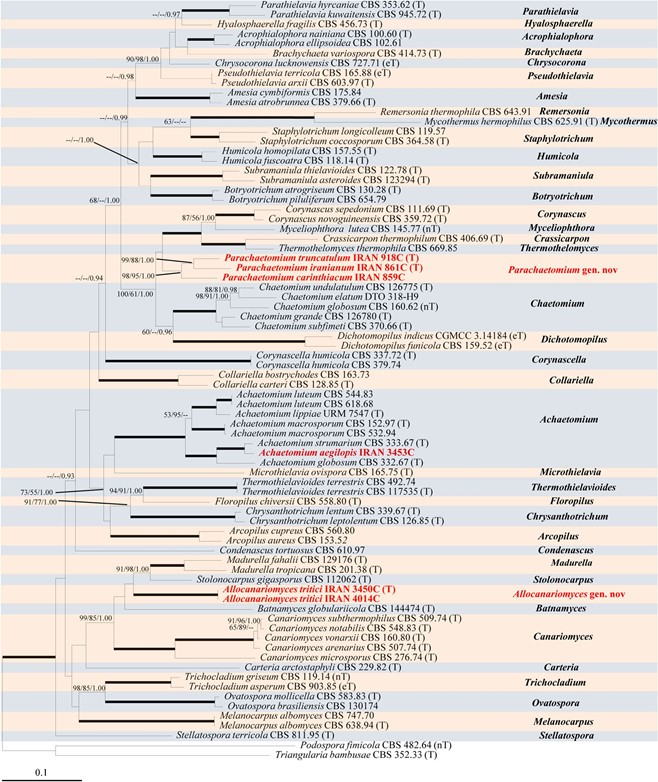Allocanariomyces Mehrabi, Asgari & Zare, Mycol. Progr. 19(12): 1417 (2020)
Index Fungorum number: IF 835853; MycoBank number: MB 835853; Facesoffungi number: FoF 14627.
Etymology – In reference to the morphological resemblance to Canariomyces.
Diagnosis – Reminiscing Canariomyces and Stolonocarpus in having non-ostiolate perithecia and often fusiform ascospores. Distinguished from other genera by cells of the perithecial wall arranged in a textura epidermoidea, densely granulated ascospores, showing a distinct subapical germ pore, and humicola-like anamorph. Ascomata superficial, globose to subglobose, non-translucent, solitary, non-ostiolate, glabrous, connected to the agar by rhizoidal hyphae; tissue type in ascomatal wall textura epidermoidea in surface view. Asci evanescent, spherical, ovate or pyriform, stalked, eight-spored. Ascospores arranged irregularly in the ascus, one-celled, brown, fusiform, densely granulate, with a distinct, subapical germ pore. Anamorph humicola-like.
Type species – Allocanariomyces tritici Mehrabi, Asgari & Zare
Notes – The four-locus phylogenetic analyses (Fig. 1) showed that Allocanariomyces is a monotypic genus forming a single lineage within the Chaetomiaceae (ML = 100%/ MP = 100%/BI = 1.00). It was grouped within the clade accommodating Batnamyces, Canariomyces, Madurella, and Stolonocarpus (Fig. 1, 99%/85%/1.00). Allocanariomyces is also morphologically similar to Canariomyces (von Arx 1984; Wang et al. 2019b). Both genera have non-ostiolate perithecia, fusiform ascospores, and a humicola-like anamorph. However, Canariomyces (Wang et al. 2019b; Hyde et al. 2013) is distinct from Allocanariomyces in having solitary to aggregated perithecia often covered by subhyaline to brown aerial hyphae, perithecial walls of textura angularis, asci without visible stalks and non-granular, ornamented ascospores with a subapical or apical germ pore. Besides, in the type species of Canariomyces, Can. notabilis, conidia are often arranged in basipetal chains (von Arx 1984), while Allocanariomyces species only produce solitary conidia.

Fig. 1 RAxML tree based on analyses of a combined dataset of ITS, LSU, TUB2, and RPB2 sequences. Bootstrap support values for ML (ML-BS) and MP (MP-BS) ≥ 50% and Bayesian posterior probabilities (PP) ≥ 0.90 are shown as ML/MP/BI above or below the nodes. The branches with full statistical support (ML-BS = 100%; MP-BS = 100%; PP = 1.0) are thickened. Newly described taxa are shown in red typeface. The scale bar shows the expected number of changes per site. The tree is rooted in Podospora fimicola and Triangularia bambusae (Podosporaceae). (T), ex-type strain; (eT), ex-epitype strain; (nT), ex- neotype strain
Species
